Bugatti Is Untouchable: The Firm's Lead Bespoke Designer On Creating True Automotive Art
Bugatti unveiled the one-off Golden Era last year, a unique Chiron Super Sport built to celebrate the marque’s two golden eras: 1909 to 1956, and 1987 to 2023. Bugatti has an extensive history of bespoke creations, both with pre-war coachbuilt cars and with the Veyron and subsequent modern models, but the Golden Era is something truly special. This Chiron is covered in dozens of hand-drawn sketches of historic Bugatti cars, created with pencil directly on the bodywork.
During Monterey Car Week last summer I got to chat with Jascha Straub, the design manager of Bugatti’s Sur Mesure customization program, while getting close-up and personal with the Golden Era Chiron. Not only did I get to learn all the details of the car’s creation, I got to watch Straub do some example sketches on spare Chiron body panels. Never in my life have I been this captivated by an automobile, to the point of becoming emotional. Over the course of a few days I spent hours walking around it and taking in all of the details. The Golden Era Chiron is the most outrageous, breathtaking piece of automotive artwork I’ve seen, and it exemplifies why Bugatti is, and has always been, untouchable.
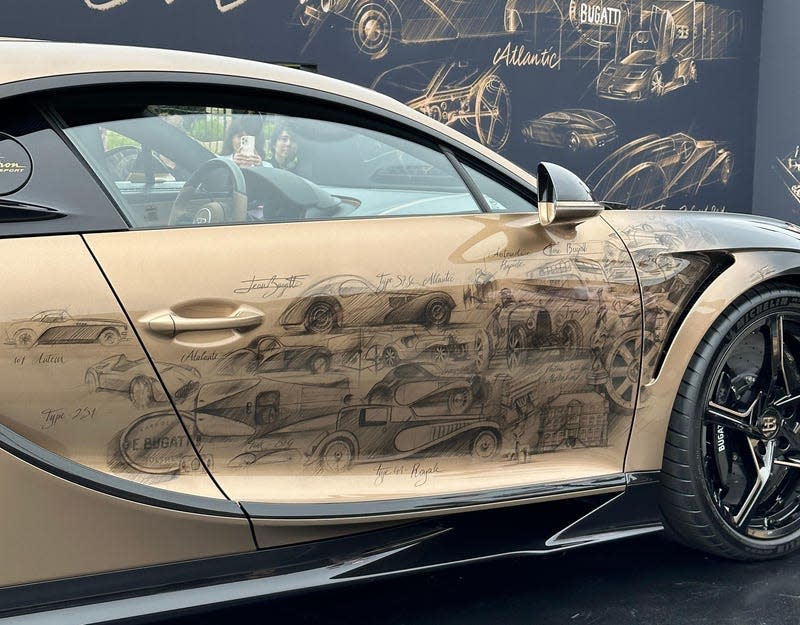
The Sur Mesure division only has the bandwidth to touch a few cars per year, and this one is maybe the most extravagant and ambitious yet. One of the world’s most prolific modern Bugatti collectors prompted the Golden Era Chiron project; he wanted a car that would celebrate Bugatti’s lengthy history as the W16 era came to a close. He left it up to the Sur Mesure team to come up with what to do, and four different ideas were presented to the buyer. Straub said the customer “immediately fell in love” with the sketch idea, and development started.
“It’s a journey together with the customer, we would like to have it as a collaboration between Bugatti and the customer, not only a product that we sell to him,” Straub said. “I mean, it’s like a friendship also. As designers we were really happy that he trusted so much in us that we’d make it right. But, of course he was highly involved. We invited him to the design studio, he was looking over our shoulders when we were sketching on the doors and so on. It was really nice, he was always super, super kind and he supported the whole thing.” No pressure!
There have been many Veyrons and Chirons with intricate liveries, graphics and paint jobs before, but Bugatti had never before created art directly on the bodywork in such a way, so it took a long time to develop. “We thought ‘okay, we will sketch something and then clear coat it,’ but everything behind it was so much more challenging,” Straub said. “We wanted to do something very special and we wanted to do exactly this, because this for us was to go one step further from what we’ve done before.”
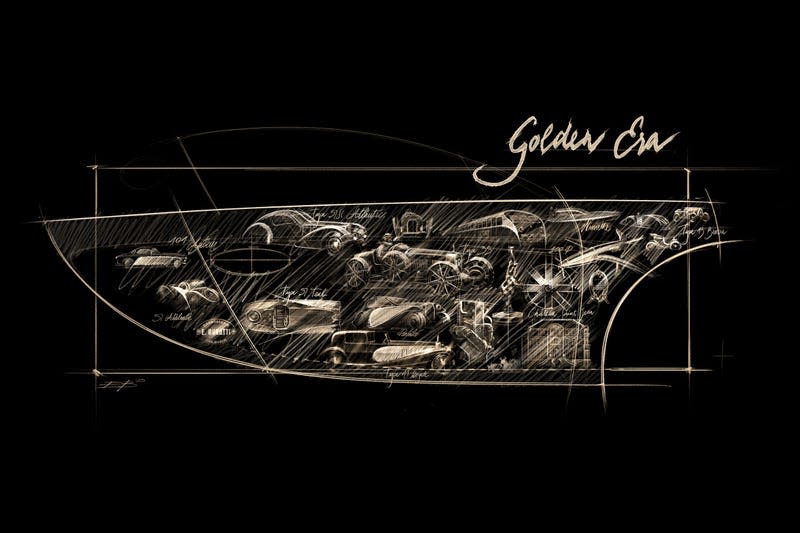
Before pencil could be put to metal the design team did several 2D mockups in photoshop, laying out the canvas for the art and arranging where each sketch would go, which Straub said helped a lot. There are 45 different individual drawings in total, with the driver’s side getting the modern era and the passenger side the classic era. Straub said that “in the end it came out completely differently,” and they couldn’t just do the car exactly like the mockup. “The surface is not flat like a paper so we had to cheat on the cars to make them not look squeezed or stretched,” he explained.
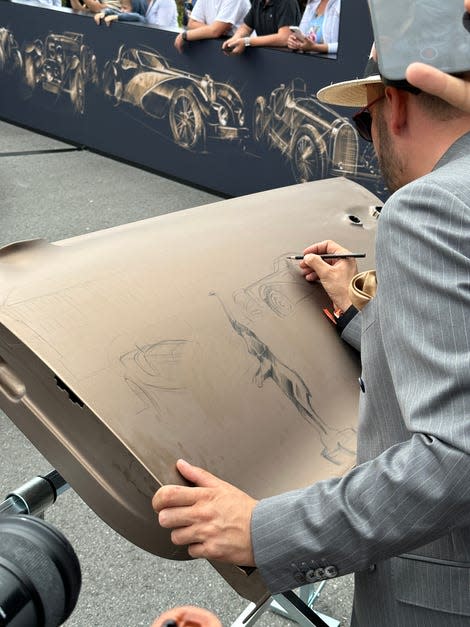
Different types of pencils and pens were tested on prototype parts while the paintwork was developed in parallel. “It was so important that the sketches looked like we sketch on paper,” Straub said, and that proved difficult, to say the least. They wanted the grain from the pencils to be visible, and for shading and highlights to look natural. Straub said the painters told them the grain from the pencil would crack the clear coat, so a new process had to be created. “We paint the ground color, the gold, then put one layer of clear coat on it, slightly sand it, and then we start to sketch on it”
“But the problem is then you don’t have enough contrast, that’s why after the first loop of sketching they go again over it with clear coat, slightly sand it off again, then we do another layer of sketches.” Straub explained that every drawing you see on the body was done at least three or four times over to achieve the right amount of contrast. The artwork also needed to look right with the fade effect of the paint, which starts off in metallic Nocturne Black at the front but becomes the new Doré gold around the front fenders, and some of the drawings had to contend with the seams for the different body panels.
The designers couldn’t erase their work, either. Instead, because of the clearcoat and multilayer sketch process, any mistakes had to be sanded away, fixed and then clear coated back over. They also had to wear gloves, because the oils on their skin could affect the sketches in progress.
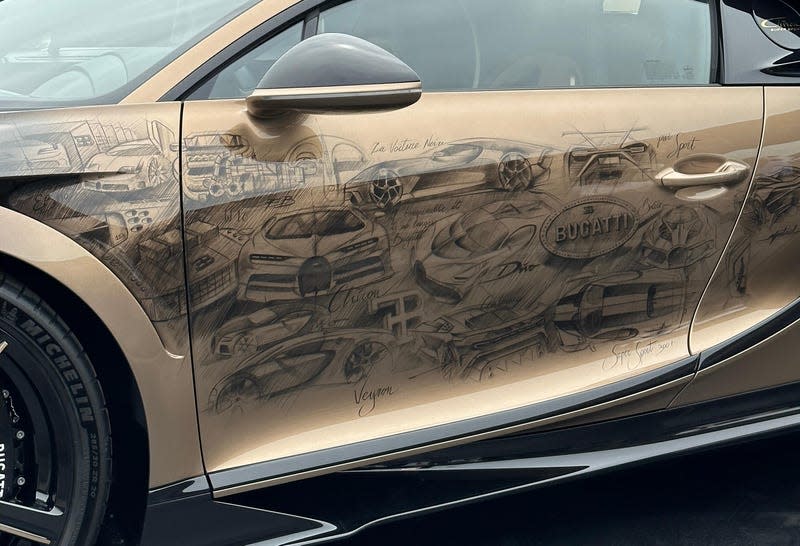
“Mistakes were made, but somehow it’s also charming,” Straub said. “If there is a line that is not completely correct, then you just keep it because it’s part of the whole sketching process.” That’s part of why the car looks so astonishing — it genuinely does look like an artist’s sketchbook come to life, and Straub said that was the goal.
In total five different designers worked on the Golden Era, with three doing the majority of the work. The sketches are of all different angles and have different levels of stylization, shading and detail, but it’s all cohesive. Straub said it wasn’t like each designer had their own assigned pieces; it was a collaborative, more free-flowing effort where the designers would help each other with the various sketches, with multiple people having a hand in the work. That’s part of how the art looks so consistent across the car, so it doesn’t feel disjointed or like the styles don’t match.
Straub says the team, along with the head of design Frank Heyl, decided they couldn’t just put random cars on the Chiron; everything had to be intentional. “We had to find a certain chronology and we had to make it romantic, all the romance and the strategy and the emotion of the Bugatti history comes from what happened around it,” Straub said, and that goes for both the modern and classic sides of the car.
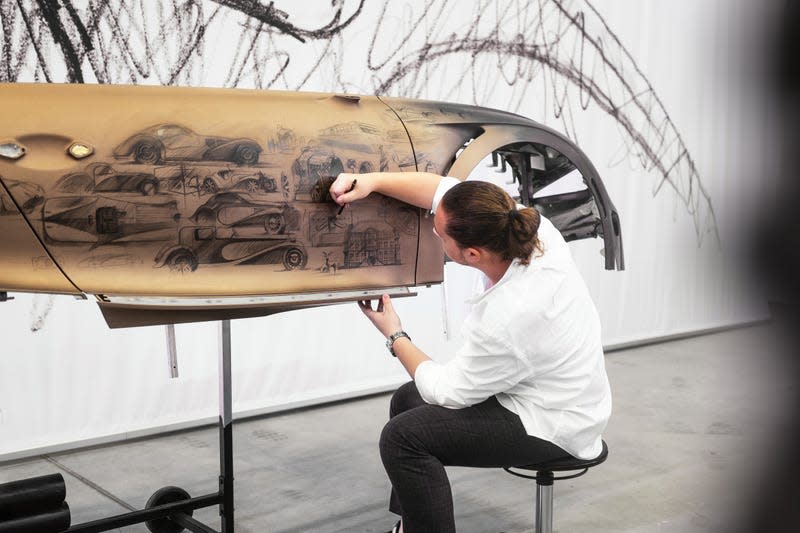
It’s not just Bugatti automobiles that are represented in the artwork — there are sketches of boats, buildings, sculptures, planes and trains. Bugatti’s emblems and logos throughout the years are depicted, along with detailed drawings of wheels, engines and grilles. “This was important to us. The two golden eras of Bugatti, the history and the modern part, it’s more than the cars itself. The Bugatti family was a family of artists, that’s why we also have the sculpture of Rembrandt Bugatti, we have the furniture of Carlo Bugatti, and so on. This was the aim, to put the whole history onto the car.”
On the modern side of things, the artwork starts with the EB110 era at the front fender and finishes with the Mistral. The Veyron, four-door Galibier concept, Centodieci, Divo, Bolide, multiple Chiron variants and La Voiture Noire are all present, with each sketch accompanied by a freehanded script of the name. Most prominent on the classic side are the Type 35, the Type 57 SC Atlantic and the Type 41 Royale — all direct inspiration for the Chiron’s replacement — but lesser-known Bugattis like the Superprofilée, Type 101 Antern, Type 56 and Type 251 are also featured. Shading and other flourishes help each drawing look like they belong as one big canvas, instead of lots of separate drawings placed together.
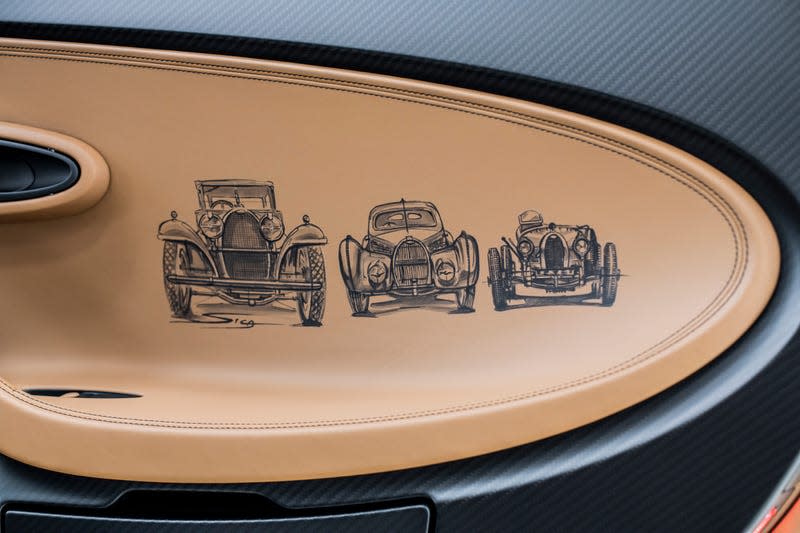
While the interior isn’t quite as spectacular as the exterior, the artistry continues. Bugatti has produced a number of Veyrons and Chirons with artwork on the door panels that’s typically stitched, printed or embroidered, but the Golden Era has more sketches done directly on the leather. The driver’s side door card shows the front ends of an EB110, Veyron Super Sport and Chiron Super Sport, while the passenger side has a Type 35, a Type 57 SC Atlantic and a Type 41 Royale.
Straub told me a special ink was used to directly paint on the pieces of leather, with a protection coat put on top so that it will withstand decades of wear. It took several tries to get right, as the leather was laid flat for the sketches but in the car it’s placed on a curved surface. If done normally, this would lead to the drawings looking distorted or off-kilter, so they had to take that into account when creating the artwork.
One detail that Straub is proud of are the exterior badges, which were all finished in gold for the first time. “In the beginning it was not really matching because we wanted to paint it in just the same gold [as the car],” he said, “but then we thought ‘we have to put a detail that makes the car a jewel, like it’s rolling art.’” So instead, the “macaron” front emblem, the EB emblem on the rear and the Chiron Super Sport scripts placed just ahead of the scoops were all plated in actual gold.
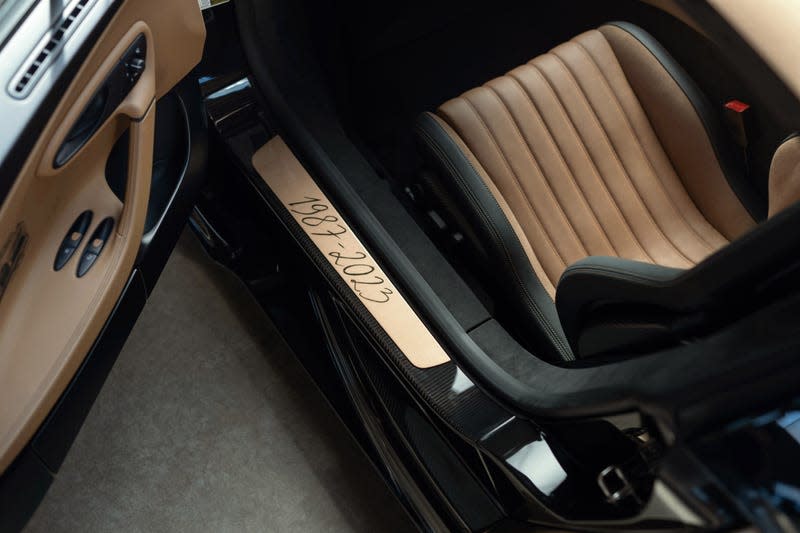
The door sills are another subtle touch. “In the beginning I thought I’ll just write Golden Era there, which would have been okay, but in the end we said ‘no, let’s put an easter egg,’” said Straub. Using the same pencil technique as the exterior panels, the driver’s side sill says 1987-2023 while the passenger sill says 1909-1956.
I asked Straub if he has a favorite Bugatti model that might be overlooked by some, as many people don’t realize just how many different cars the company created (and how different many of them were.) “For me, especially as a designer, you could consider Ettore Bugatti as a genius. He was a product of his own brand, and he was a visionary guy. But we should never forget, and especially from a designer’s point of view, Jean Bugatti,” Straub mused. The son of company founder Ettore, Jean was a designer and a test driver for the brand who developed some of Bugatti’s most spectacular models before tragically passing away while testing the Type 57 Tank. “He was somebody that really, really pushed the brand, and I think outside many people don’t really know how important Jean Bugatti was”
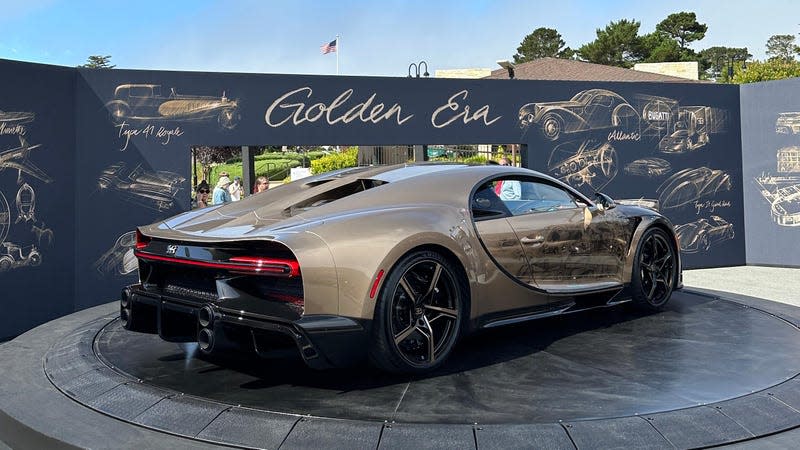
“I really, really love the cars of Jean Bugatti. Of course the Type 57 Atlantic everybody loves, but I would say also the Atalante and the Type 55 Jean Bugatti Roadster.” Jean’s most outrageous car was the Type 41 Royale, at the time the largest and most expensive car in the world, superlatives that still stand today. “You compare the Royale to other cars of the time and you see how he understood proportions. This was supercar proportions of that time, and it was very luxurious. It shows you how talented Jean Bugatti was.”
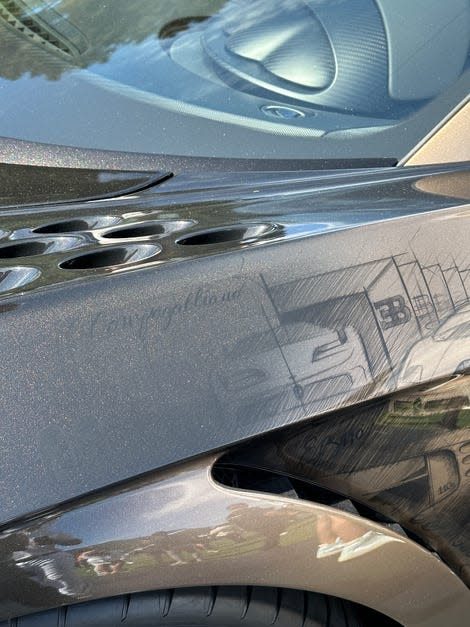
Prominently featuring the EB110 was also important to Straub and the team. Not only are there multiple sketches of the car on the body, but the La Fabbrica Blu (The Blue Factory) where the Eb110 was produced is also represented. “The [modern] side starts with 1987 when Romano Artioli had the ambition to revive the brand with the EB110, and this is really important for the whole history. In that time, it was so modern, and I think for that region in Italy it was also something very special.”
I mentioned how ahead of its time the EB110 was — it had all-wheel-drive and a quad-turbo V12, for god’s sake! — and Straub appreciated my recognition of the supercar. “There are still people that say ‘ah, the EB110 was not a real Bugatti’ because it was not coming from Molsheim. But honestly, the approach and how they did it was definitely Bugatti-like absolutely. If you compare it to the competitors of that time that were using components and engine parts of existing cars, for the EB110 everything was designed from scratch — like the monocoque, the engine, everything. This was really remarkable in that time.”
The Sur Mesure team is very limited in how many cars it can produce by the nature of how consuming it can be in terms of energy, resources and time, and Bugatti also just doesn’t want every car to go through the Sur Mesure division — if every car is that so bespoke, then none of them would be. But with the upcoming Mistral and the Chiron’s replacement, Straub says the team is “working to get better and highly individualized cars, and this is definitely the demand of the customers.”
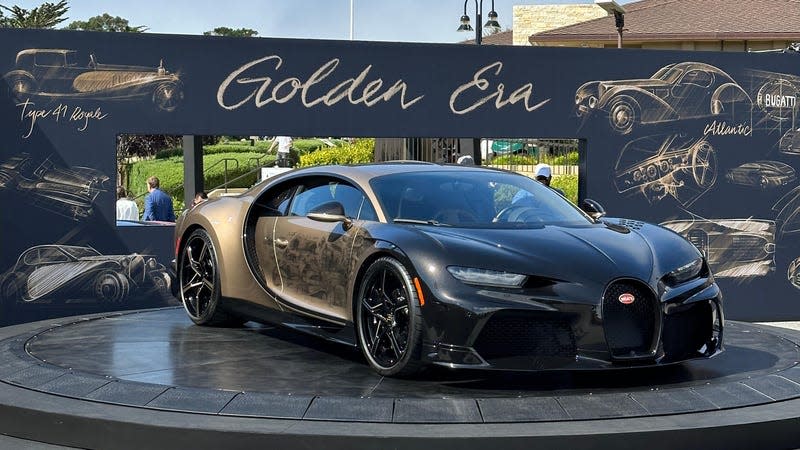
Sure, many Bugattis reside in private collections, never to be driven, but there is also a huge cohort of Bugatti owners that drive their cars regularly and bring them to shows. (I can think of multiple daily driven Chirons I see in LA.) Both types of Bugatti owner are valid to Straub. “Some of the customers see their car as an artwork and they collect it, but we also have customers that drive around a lot,” said Straub. “This is also for the fans, but for us it’s a sign of the quality and how usable the car is, and also it’s a nice gesture for us that we can see our work driving around the street.”
When Maté Rimac took over as Bugatti CEO in 2021, a lot of people were worried that Bugatti would immediately go electric, but that’s decidedly not the case. The next Bugatti will use a naturally aspirated V16 developed just for the model, and the Bugatti philosophy will stick with analog luxury. “He’s a total petrolhead, he’s absolutely into cars, that’s why I think it’s a good thing,” Straub said about his new boss. “With him we definitely have somebody that really, really pushes us to strive for the best. This is the only thing we need. He understands the Bugatti brand value, he understands the history and the DNA of Bugatti, and that’s why I think it’s only a win-win for us and for him.”
As for the Chiron’s successor, which debuts June 20th, Straub would only tell me that “it’s something really impressive.” Of that I have no doubt.
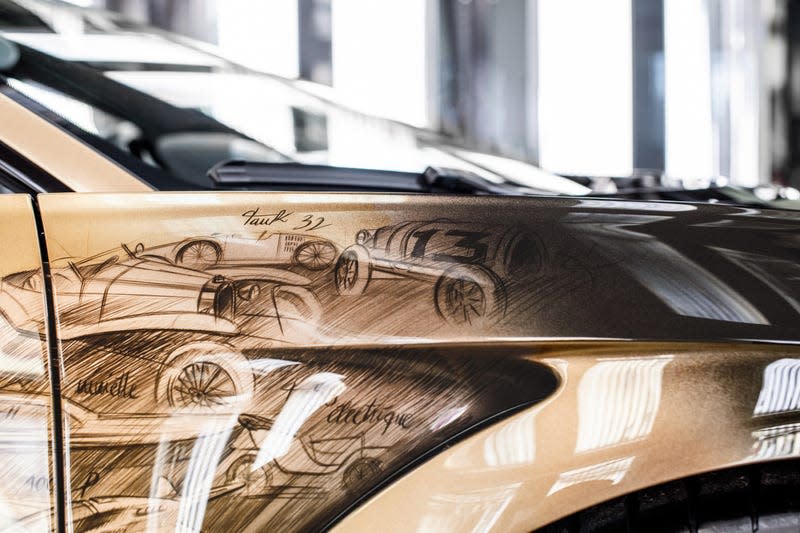
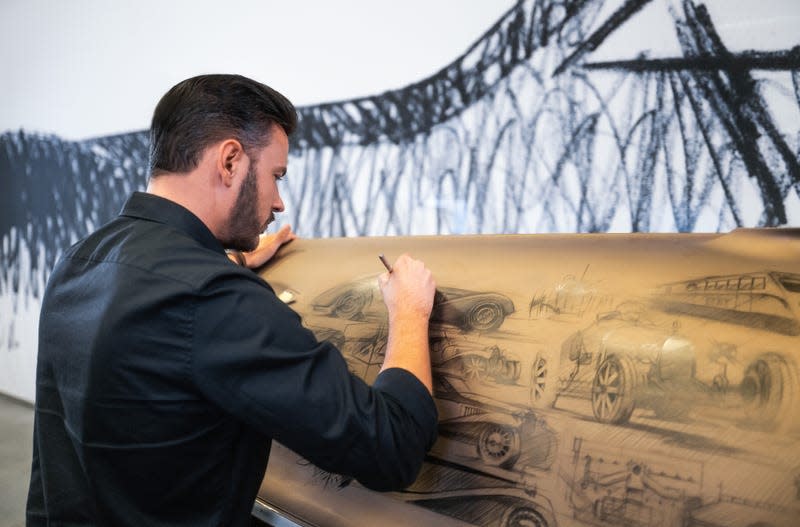
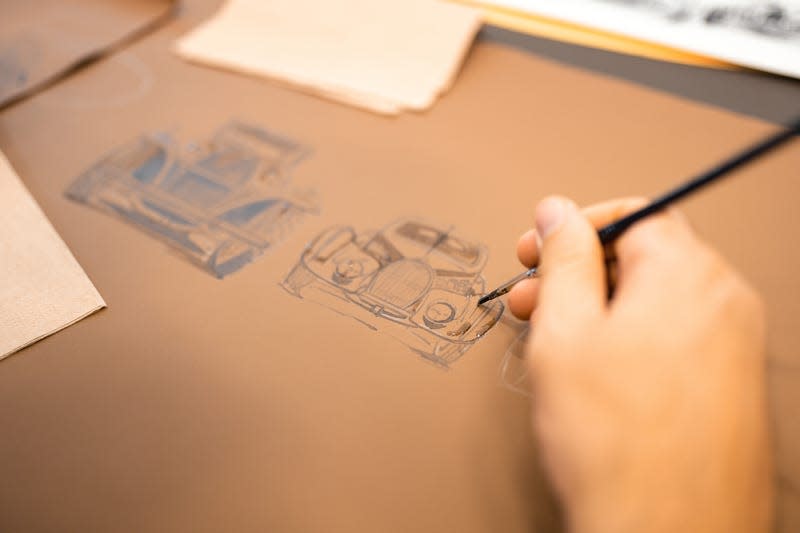
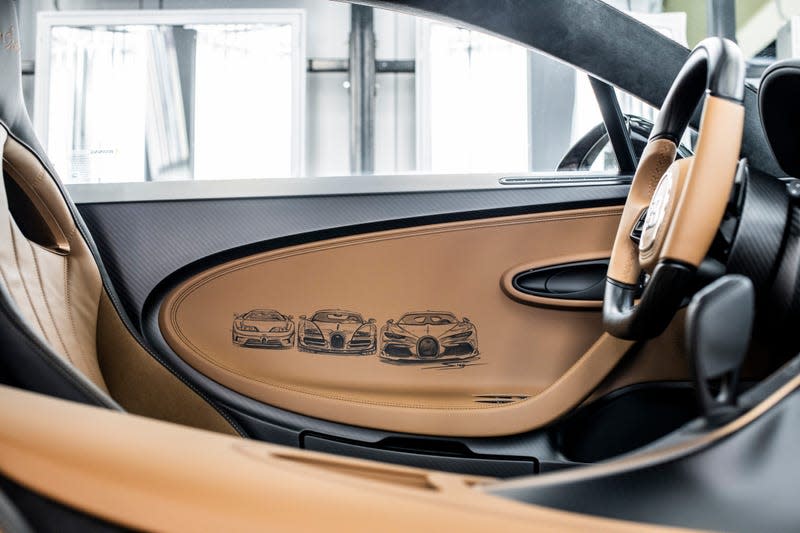
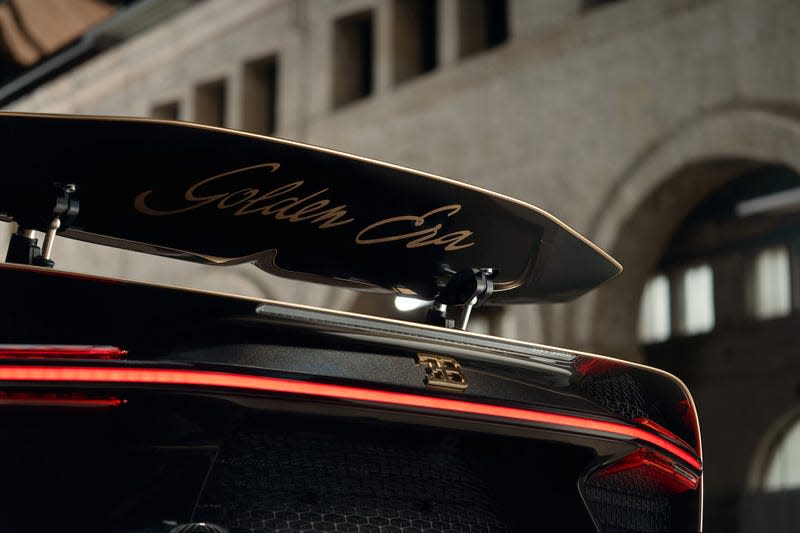

 Yahoo Autos
Yahoo Autos